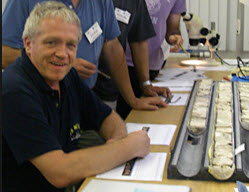Conference registration is required for enrollment in field trips and short courses, with the exception of the More! Rocks in Your Head teacher program. See the Registration page for details on registration options. Save with Early Bird rates until August 16th! Reduced cost for students!
Dr . Andre Droxler of Rice University will lead some lucky geoscientists to Central Texas to study Paleozoic carbonate mounds in the field. This would be of interest to those interested in stromatolites, microbial mats and carbonate stratigraphy. The trip will leave from the Hilton Americas at 3:00 pm on Thursday, September 17, 2015, and return to Houston on Sunday, September 20, 2015. This popular field trip features lots of outdoor activities in the beautiful Hill Country of Texas.
. Andre Droxler of Rice University will lead some lucky geoscientists to Central Texas to study Paleozoic carbonate mounds in the field. This would be of interest to those interested in stromatolites, microbial mats and carbonate stratigraphy. The trip will leave from the Hilton Americas at 3:00 pm on Thursday, September 17, 2015, and return to Houston on Sunday, September 20, 2015. This popular field trip features lots of outdoor activities in the beautiful Hill Country of Texas.
Maximum number of participants: 20 (4 Student spots)
Cost: $750 per person; Reduced price of $125 for students (includes transportation, guidebook, kayak rental, and hotel; does not include meals or refreshments)
Microbial facies are highly varied throughout the geologic record and are important reservoirs in rocks ranging from Pre-Cambrian to Cenozoic. The field trip to Cambrian microbial facies in the Mason Texas area will highlight several aspects of microbialite reservoirs, including their composition, size, and geometry. The occurrence of the Mason, Texas, microbialites will be placed in a sequence stratigraphic framework and their specific depositional setting will be discussed and compared to known microbialite reservoirs, including those in the Arbuckle Group, Tengiz field, and the pre-salt occurrences in Brazil. The Mason, Texas, outcrops afford spectacular views of both cross-section and plan views of microbialite facies, offering an opportunity for a truly 3D view of the architecture of these potential reservoirs.
Spectacular examples of microbialites (stromatolitic and thrombolitic) are found in Upper Cambrian carbonates of the Morgan Creek Limestone, Point Peak, and San Saba Members of the Wilberns Formation near the town of Mason in central Texas. These microbialites occur within the larger scale transgressive phase of the Sauk IIIA supersequence following a major unconformity at the Sauk II -Sauk IIIA supersequence boundary. Depositional geometries and textures have been remarkably well preserved with only minor dolomitization in some stromatolitic and oolitic facies. Thin-section study of the microbialites also reveals different calcimicrobes; including Girvanella, Epiphyton, Renalcis, and the pseudofossil Nuia. The Morgan Creek limestone, Point Peak, and San Saba Members of Wilberns Formation crop out around much of the Llano Uplift area and we will be fortunate to take advantage of excellent exposures along segments of the Llano, James, and San Saba Rivers, and Mill Creek, some of them accessible on private ranches only in the past 2.5 years.
<<Back to Field Trips Overview